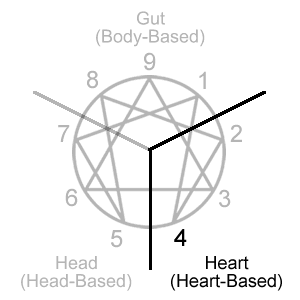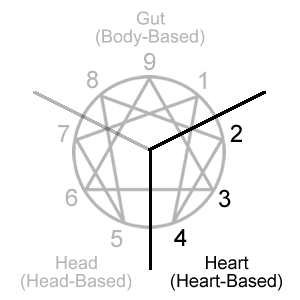Enneagram Type 4 Center: Heart/Heart-Based Type

The Heart Center
Type 4 is located in the 234 triad which is often described as the heart or heart-based center.
-
The heart types are focused on interpreting, expressing, and reacting to one’s own emotions or the emotions of others. More specifically, the heart center focuses on what's emotionally significant in the sense that emotions are an indication of how strongly a person resonates with or against something or someone.
This may involve being attentive to the emotional needs and desires of others, seeking emotional affirmation for oneself from others, and expressing one's own unique emotional impression of the world.
Type 4 has emotional impressions of the world which create a rich internal emotional reality. They base their sense of self on this. To express or share this inner emotional world is to share oneself. It can be challenging however to find a way to do this. It can seem like others don't have this same emotional senistivity which can also make the type 4 feel different from other people. This sense of difference can alternate between feeling defective and feeling special.
Type 4 Shame
The shame triad consists of types 2, 3, and 4. Shame for these types involves the heart center. It can be thought of as a feeling of deficiency for not living up to a more idealized sense of self.
This may involve initiating connection with others to avoid feeling unlovable or unimportant in the lives of others, finding value and worth through performance and accomplishment, and finding significance by cultivating and expressing one's uniqueness.
Type 4 shame comes from feeling different from others. It can seem like others are more capable in areas that the type 4 is not. This can sometimes lead to a sense of defectiveness. In compensation, they may search for what makes them uniquely special and try to live from that sense of self instead.
Type 4 Emotional Center
The core focus of the Enneagram types labels the 234 triad as the Emotional Center to more clearly differentiate how those types use that center.
- Type 2: Emotional Connection - connects to others through emotional empathy.
- Type 3: Emotional Ambition - finds validation through achievement and recognition.
- Type 4: Emotional Authenticity - expresses what feels true and real for oneself.
What Enneagram authors say about the heart center

Below are samplings from some popular or well-known Enneagram authors. Click on the sources after the descriptions to further explore these interpretations.
-
The Feeling Triad1
Types Two, Three, and Four are concerned with self-image (attachment to the false or assumed self of personality). They believe that the stories about themselves and their assumed qualitites are their actual identity. Underneath their ego defenses these types carry a great deal of shame. -
Feeling-based Intuition: Points Two-Three-Four2
- Two - Empathically altering to meet the needs of others. The feeling of becoming what other people want. Emotions alter before the mind can intervene.
- Three - Chameleonlike shift of persona and personal presentation to embody the qualities necessary to get the job done. Focus of attention is on the task, or on the reaction of others to the task. Persona can shift automatically and appropriately before the Three has mentally decided what to do.
- Four - Matching the emotions of others. Taking on their pain. Emotional resonance. Fours say that they can tap into the emotional state of absent family, lovers, and friends.
-
Heart Center3
If you are a Heart Center type (Two, Three, or Four) you tend to perceive the world through the filter of emotional intelligence. You depend more than other types on the approval and recognition of others to support your self-esteem and your desire for love and connection. To ensure that you get that approval and recognition, you create an image of yourself that gets others to accept you and see you as special. When threatened, distress, panic, and sadness occur. -
The Feeling or Heart Triad (2, 3, 4)4
These numbers are driven by feelings: Twos focus outwardly on the feelings of others, Threes have trouble recognizing their own or other people’s feelings, and Fours concentrate their attention inwardly on their own feelings. They each take in and relate to life from their heart and are more image-conscious than other numbers. -
The Heart or Feeling Center (Image)5
- Twos are interested in people and in nurturing. They want to present a loving image.
- Threes like to be seen in a good light, according to socially agreed-upon norms.
- Fours have strong needs to express themselves and to be seen as original.
-
The “heart” center or “emotional” center (Points 2, 3, and 4)6
regulates the feeling function: the experience and expression of emotions. It allows you to feel your emotions and connect to others through empathy; but overuse (or misuse) can lead to oversensitivity, insensitivity, or emotional manipulation.
Sources
1Book: The Wisdom of the Enneagram; Website: The Enneagram Institute
2Book: The Enneagram; Website: The Narrative Enneagram
3Book: The Essential Enneagram; Website: Dr. David Daniels
4Book: The Road Back to You
5Book: The Enneagram Made Easy
6Book: The Complete Enneagram; Website: Chestnut Paes Enneagram Academy
The Tri-Centers
The tri-center approach to the Enneagram types looks at an individual in terms of three types, one type from each of the three centers (i.e., gut, heart, and head). There may also be a preferred order to those three types (i.e., primary, secondary, and tertiary centers).
-
The Heart Type
If your primary or basic Enneagram type is 4 then your primary center is the heart center and type 4 is your heart type.
The remaining two types in your tri-center will come from the other two centers.
The Gut Type
Your gut type will be type 8, 9, or 1.
There are several ways to interpret what the gut or body types represent. They may be thought of in terms of sensory-somatic (bodily felt sensation), sensory-motor (physical movement and activity), or instinctual (gut decision making).
This may involve taking action based on one's gut instinct, getting pulled along by the agenda of others, and actively trying to correct what's seen as wrong in the world.
The Head Type
Your head type will be type 5, 6, or 7.
Although the head types can be thought of in terms of reasoning, analyzing, and other typical thinking functions, a useful distinction from the other two centers can be made in terms of anticipating and preparing for future possibilities.
This may involve gathering data and facts in order to better predict outcomes, preparing for negative potentialities that might occur, and planning or pursuing activities that provide enjoyment and avoid discomfort.
-
Possible Tri-Centers for Type 4
4-5-8 4-8-5
4-5-9 4-9-5
4-5-1 4-1-5
4-6-8 4-8-6
4-6-9 4-9-6
4-6-1 4-1-6
4-7-8 4-8-7
4-7-9 4-9-7
4-7-1 4-1-7
Enneagram Tests to Help Determine Centers

The Enneagram personality types group the nine types into three centers of intelligence often referred to as the gut, heart, and head centers.
These tests help you find your dominant type in each center and the order of preference for those centers.
-
Dominant Type in Each Center with Wings Test
This test determines your dominant type in each center (aka tri-center, trifix, tritype, truetype) along with the wings of those types.
Use when you want to know your tri-center or tri-center with wings. -
Enneagram Type Preference Test
This test produces a scored list of all nine types.
Questions are forced-choice, similar to the method used by the Riso-Hudson Enneagram Type Indictor (RHETI).
Use to determine type, wings, gut/heart/head types, and tri-center. -
Center Type Comparison Test
This test scores the three types in a given center to determine your dominant type within that center (gut, heart, or head type).
Use when you don't know your dominant type for one of the centers. -
Type Comparison Test
This test compares any two types, producing a score for each.
Use when unsure of your tri-center order or which of two types is preferred for a center.
To learn more about Enneagram personality type 4 click here.
Click here for the Complete Guide to the Enneagram.
This free guide explains- the nine Enneagram personality types
- the many type variations within type
- where the types came from (origins and history)
- how the types use the Enneagram symbol
Click here for Enneagram tests.
These free tests help you find your- primary type
- candidate types
- preferred wing
- intinctual subtype
- instinctual variant stacking
- center types (gut, heart, and head)
- tri-center with wings